Spacing, Interleaving, the Testing Effect and Distributed Practice (the Diet Coke version)

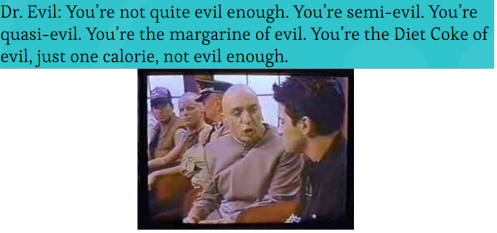
I haven’t released a blog in a while and this blog was ready to be released a few months ago. However the school Timetable and Euro 2016 took up all of my recent time.
I am very conscious that many may claim that what I am describing here does not truly represent Spacing/Interleaving/Testing/Distributed Practice (delete as appropriate) so I am claiming up front that this is the Diet Coke version.
I just wanted to share a strategy I am trialling with my Year 9 Maths class (Set 6/6). There is a far higher percentage of eFSM (or Pupil Premium students) in my group (27%) compared to set 1 (6%). Half of my class are also August babies (!) so are clearly still trying to catch up with their peers. I feel the pressure teaching this class because I need them to close the gap with their peers before the GCSE years. In short I have been looking at any strategies which may enhance their learning. I have been coming back to spacing, interleaving and distributed practice after reading some super blogs like this by @shaun_allison and @atharby, this by @LearningSpy and this, this and this by the learning scientists @AceThatTest.
The above blogs give a far more accurate account than I ever could but the short version is that it is based on the work of Ebbinghaus undertaken in the 19th Century. We often rage at the rate at which students forget whilst perhaps overlooking that this is exactly how the brain works.

Credit: http://www.mentormegate.com/wordpress/tag/the-forgetting-curve/
What is perhaps more remarkable is that if we can revisit work at the point of forgetting (by spacing the content) we can increase the amount of content we/our students remember.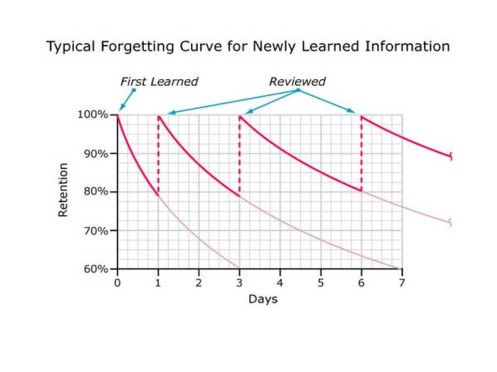
So if we space (and interleave) the coverage of the curriculum we would expect our students to remember more than if we just covered it in blocks and moved on.
The testing effect can be shown by this clever study by Roeder and Karpicke (2006).
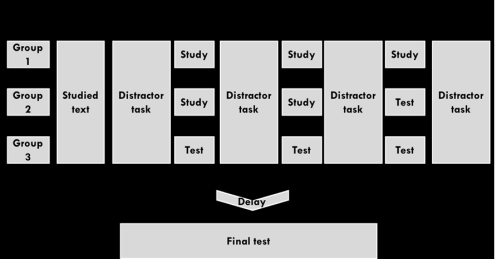
Intuitively we may expect group 1 to have the greatest recall. And they do in the short term (testing after 5 minutes). But delaying the final test until a week later shows a remarkable effect.

There are a few caveats though. For the testing effect to be truly beneficial the stakes for the learners need to be a low as possible.
So how could I use the spacing and testing effect with my Year 9 class? The answer lay in the “do now” that we religiously do at the start of the lesson. The “do now” idea comes from Doug Lemov and I wrote briefly about it here.
This is what my “do now”s looked like last year:

The 5 questions I would invariably make up on the spot and it was roughly based on what we had been studying over the course of the year up to that point. It was very ad hoc though it usually would be a different 5 each lesson. I would go through each question and then ask how many pupils got 5/5, 4/5 etc. In the middle of this year I realised that with a few tweaks the “do now” could potentially be really powerful in terms of improving learning. It just needed further thought.
The do now changed to this:
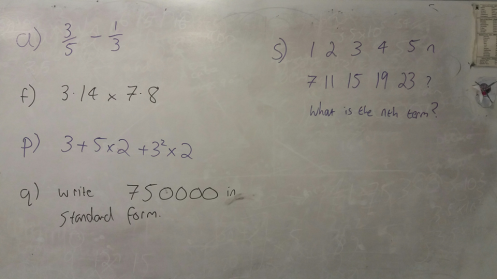
The letters related to areas of the curriculum we had already covered, for instance a) was adding/subtracting fractions. I knew I needed to better track the type of questions (for spacing) and the success, or lack of, that pupils were having. The “do now” soon morphed from a simple a lesson starter into a key component of the lesson which would often take around 15 minutes . The question type (standard form, adding fractions, collecting like terms etc) was probably seemingly random to the pupils but I was looking to genuinely space them. Pupils saw the “do now” as being as integral as the new content that would be covered later in the lesson. They quickly tuned into the fact that we were constantly revising our work and that this was a good thing!!
Another simple but important tweak happened after reading this comment on a David Didau blog by Dylan Wiliam:
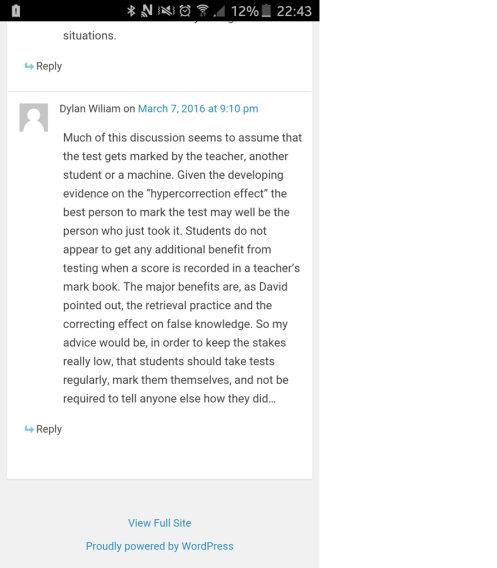
I wanted to track the relative success of each question type but I wanted to keep it as low stakes as possible. I also continued to show workings (and model my metacognition) for every question (if pupils got them wrong) to take advantage of the hypercorrection effect. I decided I would ask for a show of hands after each question to indicate who had got it right just so that I could see what we are good at, or not so good at, as a class. I stopped asking for hands up at the end for 5/5, 4/5 etc to try to remove the ego and the competition from the task. I tracked success using this format:
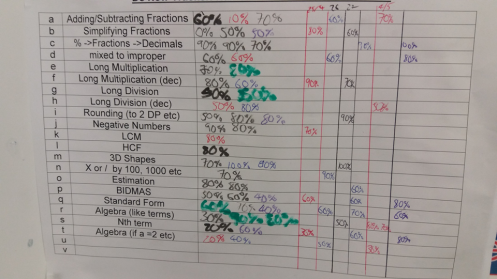
Once I started recording their % on a lesson by lesson basis I could visually see how I was spacing the different areas covered. I could deliberately build in “forgetting time” before including a recent topic in the do now. Of course it is not perfect. 3D shapes is a broad topic and success on a few questions on edges, faces and vertices doesn’t quite do it justice. Adding fractions is far narrower in terms of possible questions. And yes, the idea that I am testing work on the point that is about to be forgotten would be a bold claim. But it is what I am aiming for.
Pupils tracked their success using this sheet which they kept in their books and got out at the start of every lesson and filled in after each question:
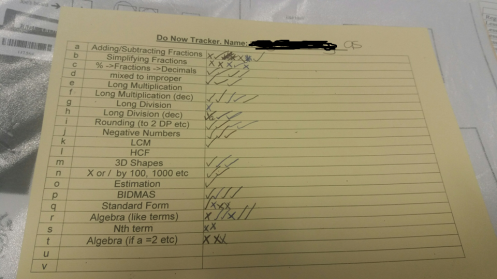
This gave two benefits. Firstly pupils could gain in confidence by seeing that there were many areas of Maths that they were remembering at any one time and secondly the crosses may go on to represent areas of weakness that would need further work before their end of year exams. This was the pupils’ ready made revision list for their exams, tailored towards their weaknesses.
One huge benefit to this system was that it would, in theory, differentiate between what pupils genuinely couldn’t do and what they just couldn’t remember.
Another tweak from running something similar last year was that if close to 100% of the class was getting a question right, rather than just thinking “they can do this so remove it from the rota for good”, I would space it out and increase the challenge the next time I included it. Also, if pupils were struggling, I would continue to work through the correct answer with them but then resist the temptation to include it next lesson. Rather, I would leave for a few lesson before testing again.
Another benefit to pupils tracking their own success was that closer to the exam I could pair pupils up and by using their own “do now trackers” they could teach each other some of the topics that each were struggling with. I gave 30 minutes to this one lesson and I was amazed at how well they responded to the challenge and how supportive they were of each other.
Barriers
The biggest barrier to implementing anything that takes advantage of the spacing and testing effect is the finite nature of curriculum time. Many teachers will feel that there is barely sufficient time to cover the curriculum, let alone to frequently test and cover work already completed.
I think we just have to find the time. In Maths this means moving away from massed practice to distributed practice. Rather than doing 20 questions on adding fractions following the explicit teaching, pupils do 5 and then move on. Whether they do 5 or 155, they are going to forget (so why waste time doing another 150!!!). By saving time here I can test them on adding fractions a further 15 times during the course of the year. So they still do their 20 examples. It is just distributed rather than massed. This barrier, and the reason to power through, is perfectly summed up by Brown, Roediger III and McDaniel in their book “Make it Stick”:
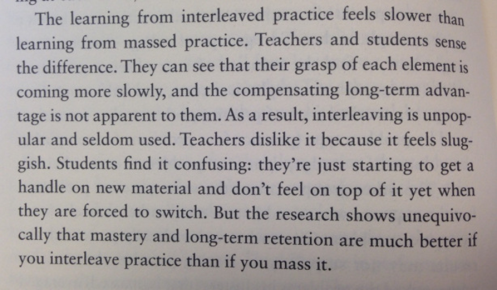
Post Exam reflection (added in recent weeks)
The exams are over and the results for my class are generally very positive. Interestingly they have performed better on the Maths paper than they did on the Numeracy paper (which was applying the Maths knowledge in a range of contexts). Whilst I am pleased that many have done well in the Maths, if I was going to repeat this next year I would provide more exposure to the reasoning type of questions rather than focussing purely on the procedural side of Maths. However, my hope would be that many of the pupils will have more Maths knowledge lodged in their long term memories to apply to reasoning style questions in the future.
Did many (all?) of the pupils do better than if I had approached the year in a more traditional manner. Of course I can’t answer that but I feel the answer is yes. I know from the day to day lessons that their confidence in their ability in Maths has improved and this is so important for many that at the start of the year “just can’t do Maths”.
Hopefully over the next two years many of the pupils will go on to achieve a C (or better) in their GCSE exams.
Next year I am going back to teaching just Science. I need to think about how I can make use of the spacing and testing effect in a content heavy Science curriculum. I have a few ideas. None as innovative as this from @MissDCox but hopefully I will blog some ideas I will be trialling. For further reading on designing a spaced curriculum try this by @dan_brinton and this by @davidfawcett27
Thanks for reading. Constructive criticism is always welcome.
Trackbacks & Pingbacks
- (Trying to apply) Spacing in Science | mrbenney
- Threshold Concepts 2 (Planning) | NDHS Blog Spot
- Things that have influenced my teaching over the last two months or so. – Thinking about teaching
- Blogs that tell you how to teach better – Thinking about teaching
- Blogs that tell you how to teach better – Elephant lessons
- And now for something a little bit different…. | Just a Teacher Standing in Front of a Class
- Interleaving | Driffield School and Sixth Form Teaching and Learning Blog
- Threshold Concepts (…and the space in between- part 2) – Kaye Chem Notebook
- Differentiation, inclusion and Classroom Culture (ot #TLT17 part 3) | mrbenney
- Evaluation of “trying to apply research” in the classroom – Part 1 (the background) | mrbenney
- #rEDDurrington Slides and Links | mrbenney

Reblogged this on Y Byd a'r Betws – Blog B J Mock and commented:
Learning and teaching approaches.
Wow. There were some ‘a ha!’ Moments for me here. I teach third grade second language learners, so I find that most everything improves with repeated visits to the skill, but the organization and scheduling of concepts here is exciting and giving me some new ideas. Thank you!
Many thanks for taking the time to read and comment Ingrid.
Thank for a very thought provoking blog. I also teach both maths and science.Given the amount of content to cover in science I couldn’t give up 15mins of every lesson but could maybe squeeze in some time every week. I think it would also help remind kids that they should be reviewing topics before they get to the end of unit test and remind them of what they can already do. Thanks!
Thanks for taking the time to read and comment Kate. Funnilu enough I am only teaching Science next year and my challenge is to somehow but some spacing time during the year. I agree though; very hard in a content heavy curriculum. That is going to be my planning for the summer.
Thanks going to share with others as well- appreciate you taking the time to write out this diet coke version. It is what I need this year.